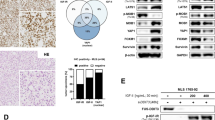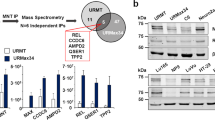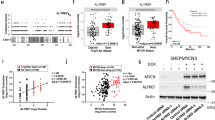Abstract
FUS (also called TLS), EWSR1 and TAF15 (also called TAF2N) are related genes involved in tumor type-specific fusion oncogenes in human malignancies. The FUS-DDIT3 fusion oncogene results from a t(12;16)(q13;p11) chromosome translocation and has a causative role in the initiation of myxoid/round cell liposarcomas (MLS/RCLS). The FUS-DDIT3 protein induces increased expression of the CAAT/enhancer-binding protein (C/EBP) and nuclear factor-κB (NF-κB)-controlled gene IL8, and the N-terminal FUS part is required for this activation. Chromatin immunoprecipitation analysis showed that FUS-DDIT3 binds the IL8 promoter. Expression studies of the IL8 promoter harboring a C/EBP–NF-κB composite site pinpointed the importance of NF-κB for IL8 expression in FUS-DDIT3-expressing cells. We therefore probed for possible interaction of FUS-DDIT3 with members of the NF-κB family. The nuclear factor NFKBIZ colocalizes with FUS-DDIT3 in nuclear structures, and immunoprecipitation experiments showed that FUS-DDIT3 binds the C-terminal of NFKBIZ. We also report that additional NF-κB-controlled genes are upregulated at the mRNA level in FUS-DDIT3-expressing cell lines and they can be induced by NFKBIZ. Taken together, the results indicate that FUS-DDIT3 deregulates some NF-κB-controlled genes through interactions with NFKBIZ. Similar mechanisms may be a part of the transformation process in other tumor types carrying FUS, EWSR1 and TAF15 containing fusion oncogenes.
This is a preview of subscription content, access via your institution
Access options
Subscribe to this journal
Receive 50 print issues and online access
$259.00 per year
only $5.18 per issue
Buy this article
- Purchase on Springer Link
- Instant access to full article PDF
Prices may be subject to local taxes which are calculated during checkout






Similar content being viewed by others
References
Åman P, Panagopoulos I, Lassen C, Fioretos T, Mencinger M, Toresson H et al. (1996). Expression patterns of the human sarcoma-associated genes FUS and EWS and the genomic structure of FUS. Genomics 37: 1–8.
Åman P, Ron D, Mandahl N, Fioretos T, Heim S, Arheden K et al. (1992). Rearrangement of the transcription factor gene CHOP in myxoid liposarcomas with t(12;16)(q13;p11). Genes Chromosomes Cancer 5: 278–285.
Basile A, Sica A, d’Aniello E, Breviario F, Garrido G, Castellano M et al. (1997). Characterization of the promoter for the human long pentraxin PTX3. Role of NF-kappaB in tumor necrosis factor-alpha and interleukin-1beta regulation. J Biol Chem 272: 8172–8178.
Biegel JA, Conard K, Brooks JJ . (1993). Translocation (11;22)(p13;q12): primary change in intra-abdominal desmoplastic small round cell tumor. Genes Chromosomes Cancer 7: 119–121.
Bratt T . (2000). Lipocalins and cancer. Biochim Biophys Acta 1482: 318–326.
Brinckerhoff CE, Rutter JL, Benbow U . (2000). Interstitial collagenases as markers of tumor progression. Clin Cancer Res 6: 4823–4830.
Caretti G, Salsi V, Vecchi C, Imbriano C, Mantovani R . (2003). Dynamic recruitment of NF-Y and histone acetyltransferases on cell-cycle promoters. J Biol Chem 278: 30435–30440.
Chen Z, Ruffner DE . (1998). Amplification of closed circular DNA in vitro. Nucleic Acids Res 26: 1126–1127.
Crozat A, Åman P, Mandahl N, Ron D . (1993). Fusion of CHOP to a novel RNA-binding protein in human myxoid liposarcoma. Nature 363: 640–644.
Diffin F, Porter H, Mott MG, Berry PJ, Brown KW . (1994). Rapid and specific diagnosis of t(11;22) translocation in paediatric Ewing's sarcoma and primitive neuroectodermal tumours using RNA-PCR. J Clin Pathol 47: 562–564.
Engström K, Willen H, Kåbjörn-Gustafsson C, Andersson C, Olsson M, Göransson M et al. (2006). The myxoid/round cell liposarcoma fusion oncogene FUS-DDIT3 and the normal DDIT3 induce a liposarcoma phenotype in transfected human fibrosarcoma cells. Am J Pathol 168: 1642–1653.
Göransson M, Elias E, Ståhlberg A, Olofsson A, Andersson C, Åman P . (2005). Myxoid liposarcoma FUS-DDIT3 fusion oncogene induces C/EBP beta-mediated interleukin 6 expression. Int J Cancer 115: 556–560.
Göransson M, Wedin M, Åman P . (2002). Temperature-dependent localization of TLS-CHOP to splicing factor compartments. Exp Cell Res 278: 125–132.
Hinz M, Krappmann D, Eichten A, Heder A, Scheidereit C, Strauss M . (1999). NF-kappaB function in growth control: regulation of cyclin D1 expression and G0/G1-to-S-phase transition. Mol Cell Biol 19: 2690–2698.
Kitamura H, Kanehira K, Okita K, Morimatsu M, Saito M . (2000). MAIL, a novel nuclear I kappa B protein that potentiates LPS-induced IL-6 production. FEBS Lett 485: 53–56.
Kovar H . (2005). Context matters: the hen or egg problem in Ewing's sarcoma. Semin Cancer Biol 15: 189–196.
Kovar H, Zoubek A, Pfleiderer C, Jug G, Auinger A, Aryee D et al. (1994). The EWS gene rearrangement in Ewing tumors: key to the disease. Klin Padiatr 206: 196–200.
Law WJ, Cann KL, Hicks GG . (2006). TLS, EWS and TAF15: a model for transcriptional integration of gene expression. Brief Funct Genomic Proteomic 5: 8–14.
Libermann TA, Baltimore D . (1990). Activation of interleukin-6 gene expression through the NF-kappa B transcription factor. Mol Cell Biol 10: 2327–2334.
Littlewood TD, Hancock DC, Danielian PS, Parker MG, Evan GI . (1995). A modified oestrogen receptor ligand-binding domain as an improved switch for the regulation of heterologous proteins. Nucleic Acids Res 23: 1686–1690.
Matsuo S, Yamazaki S, Takeshige K, Muta T . (2007). Crucial roles of binding sites for NF-kappaB and C/EBPs in IkappaB-zeta-mediated transcriptional activation. Biochem J 405: 605–615.
Matsusaka T, Fujikawa K, Nishio Y, Mukaida N, Matsushima K, Kishimoto T et al. (1993). Transcription factors NF-IL6 and NF-kappa B synergistically activate transcription of the inflammatory cytokines, interleukin 6 and interleukin 8. Proc Natl Acad Sci USA 90: 10193–10197.
Morohoshi F, Ootsuka Y, Arai K, Ichikawa H, Mitani S, Munakata N et al. (1998). Genomic structure of the human RBP56/hTAFII68 and FUS/TLS genes. Gene 221: 191–198.
Motoyama M, Yamazaki S, Eto-Kimura A, Takeshige K, Muta T . (2005). Positive and negative regulation of nuclear factor-kappaB-mediated transcription by IkappaB-zeta, an inducible nuclear protein. J Biol Chem 280: 7444–7451.
Mukaida N, Mahe Y, Matsushima K . (1990). Cooperative interaction of nuclear factor-kappa B- and cis-regulatory enhancer binding protein-like factor binding elements in activating the interleukin-8 gene by pro-inflammatory cytokines. J Biol Chem 265: 21128–21133.
Nakopoulou L, Giannopoulou I, Gakiopoulou H, Liapis H, Tzonou A, Davaris PS . (1999). Matrix metalloproteinase-1 and -3 in breast cancer: correlation with progesterone receptors and other clinicopathologic features. Hum Pathol 30: 436–442.
Ohno T, Rao VN, Reddy ES . (1993). EWS/Fli-1 chimeric protein is a transcriptional activator. Cancer Res 53: 5859–5863.
Oikawa K, Ishida T, Imamura T, Yoshida K, Takanashi M, Hattori H et al. (2006). Generation of the novel monoclonal antibody against TLS/EWS-CHOP chimeric oncoproteins that is applicable to one of the most sensitive assays for myxoid and round cell liposarcomas. Am J Surg Pathol 30: 351–356.
Olofsson A, Willen H, Göransson M, Engström K, Meis-Kindblom JM, Stenman G et al. (2004). Abnormal expression of cell cycle regulators in FUS-CHOP carrying liposarcomas. Int J Oncol 25: 1349–1355.
Panagopoulos I, Höglund M, Mertens F, Mandahl N, Mitelman F, Åman P . (1996). Fusion of the EWS and CHOP genes in myxoid liposarcoma. Oncogene 12: 489–494.
Panagopoulos I, Mandahl N, Ron D, Höglund M, Nilbert M, Mertens F et al. (1994). Characterization of the CHOP breakpoints and fusion transcripts in myxoid liposarcomas with the 12;16 translocation. Cancer Res 54: 6500–6503.
Perez-Losada J, Pintado B, Gutierrez-Adan A, Flores T, Banares-Gonzalez B, del Campo JC et al. (2000a). The chimeric FUS/TLS-CHOP fusion protein specifically induces liposarcomas in transgenic mice. Oncogene 19: 2413–2422.
Perez-Losada J, Sanchez-Martin M, Rodriguez-Garcia MA, Perez-Mancera PA, Pintado B, Flores T et al. (2000b). Liposarcoma initiated by FUS/TLS-CHOP: the FUS/TLS domain plays a critical role in the pathogenesis of liposarcoma. Oncogene 19: 6015–6022.
Rabbitts TH, Forster A, Larson R, Nathan P . (1993). Fusion of the dominant negative transcription regulator CHOP with a novel gene FUS by translocation t(12;16) in malignant liposarcoma. Nat Genet 4: 175–180.
Riggi N, Cironi L, Provero P, Suva ML, Stehle JC, Baumer K et al. (2006). Expression of the FUS-CHOP fusion protein in primary mesenchymal progenitor cells gives rise to a model of myxoid liposarcoma. Cancer Res 66: 7016–7023.
Ron D, Habener JF . (1992). CHOP, a novel developmentally regulated nuclear protein that dimerizes with transcription factors C/EBP and LAP and functions as a dominant-negative inhibitor of gene transcription. Genes Dev 6: 439–453.
Sanchez Garcia I, Rabbitts TH . (1994). Transcriptional activation by TAL1 and FUS-CHOP proteins expressed in acute malignancies as a result of chromosomal abnormalities. Proc Natl Acad Sci USA 91: 7869–7873.
Schwarzbach MH, Koesters R, Germann A, Mechtersheimer G, Geisbill J, Winkler S et al. (2004). Comparable transforming capacities and differential gene expression patterns of variant FUS/CHOP fusion transcripts derived from soft tissue liposarcomas. Oncogene 23: 6798–6805.
Ståhlberg A, Håkansson J, Xian X, Semb H, Kubista M . (2004). Properties of the reverse transcription reaction in mRNA quantification. Clin Chem 50: 509–515.
Sun SC, Xiao G . (2003). Deregulation of NF-kappaB and its upstream kinases in cancer. Cancer Metastasis Rev 22: 405–422.
Thelin-Järnum S, Göransson M, Burguete AS, Olofsson A, Åman P . (2002). The myxoid liposarcoma specific TLS-CHOP fusion protein localizes to nuclear structures distinct from PML nuclear bodies. Int J Cancer 97: 446–450.
Thelin-Järnum S, Lassen C, Panagopoulos I, Mandahl N, Åman P . (1999). Identification of genes differentially expressed in TLS-CHOP carrying myxoid liposarcomas. Int J Cancer 83: 30–33.
Totzke G, Essmann F, Pohlmann S, Lindenblatt C, Janicke RU, Schulze-Osthoff K . (2006). A novel member of the IkappaB family, human IkappaB-zeta, inhibits transactivation of p65 and its DNA binding. J Biol Chem 281: 12645–12654.
Trinh DV, Zhu N, Farhang G, Kim BJ, Huxford T . (2008). The nuclear I kappaB protein I kappaB zeta specifically binds NF-kappaB p50 homodimers and forms a ternary complex on kappaB DNA. J Mol Biol 379: 122–135.
Uranishi H, Tetsuka T, Yamashita M, Asamitsu K, Shimizu M, Itoh M et al. (2001). Involvement of the pro-oncoprotein TLS (translocated in liposarcoma) in nuclear factor-kappa B p65-mediated transcription as a coactivator. J Biol Chem 276: 13395–13401.
Vandesompele J, De Preter K, Pattyn F, Poppe B, Van Roy N, De Paepe A et al. (2002). Accurate normalization of real-time quantitative RT-PCR data by geometric averaging of multiple internal control genes. Genome Biol 3: RESEARCH0034.
Vincenti MP, Coon CI, Brinckerhoff CE . (1998). Nuclear factor kappaB/p50 activates an element in the distal matrix metalloproteinase 1 promoter in interleukin-1beta-stimulated synovial fibroblasts. Arthritis Rheum 41: 1987–1994.
Yamazaki S, Muta T, Takeshige K . (2001). A novel IkappaB protein, IkappaB-zeta, induced by proinflammatory stimuli, negatively regulates nuclear factor-kappaB in the nuclei. J Biol Chem 276: 27657–27662.
Zinszner H, Albalat R, Ron D . (1994). A novel effector domain from the RNA-binding protein TLS or EWS is required for oncogenic transformation by CHOP. Genes Dev 8: 2513–2526.
Zinszner H, Immanuel D, Yin Y, Liang FX, Ron D . (1997). A topogenic role for the oncogenic N-terminus of TLS: nucleolar localization when transcription is inhibited. Oncogene 14: 451–461.
Acknowledgements
We thank Ulric Pedersen for image processing. This work was supported by grants from the Inga-Britt and Arne Lundberg Research Foundation, the Swedish Cancer Society, Assar Gabrielssons Research Foundation and the Johan Jansson Foundation for Cancer Research. RM was supported by an AIRC grant. AS is supported by a postdoctoral fellowship award from the Swedish Research Council.
Author information
Authors and Affiliations
Corresponding author
Rights and permissions
About this article
Cite this article
Göransson, M., Andersson, M., Forni, C. et al. The myxoid liposarcoma FUS-DDIT3 fusion oncoprotein deregulates NF-κB target genes by interaction with NFKBIZ. Oncogene 28, 270–278 (2009). https://doi.org/10.1038/onc.2008.378
Received:
Accepted:
Published:
Issue Date:
DOI: https://doi.org/10.1038/onc.2008.378
Keywords
This article is cited by
-
Machine learning-based tissue of origin classification for cancer of unknown primary diagnostics using genome-wide mutation features
Nature Communications (2022)
-
Fusion protein-driven IGF-IR/PI3K/AKT signals deregulate Hippo pathway promoting oncogenic cooperation of YAP1 and FUS-DDIT3 in myxoid liposarcoma
Oncogenesis (2022)
-
Sequential targeting of YAP1 and p21 enhances the elimination of senescent cells induced by the BET inhibitor JQ1
Cell Death & Disease (2021)
-
LongGF: computational algorithm and software tool for fast and accurate detection of gene fusions by long-read transcriptome sequencing
BMC Genomics (2020)
-
Two-stage surgery for intraperitoneal and retroperitoneal multicentric liposarcoma causing hydronephrosis: a case report
Surgical Case Reports (2019)



